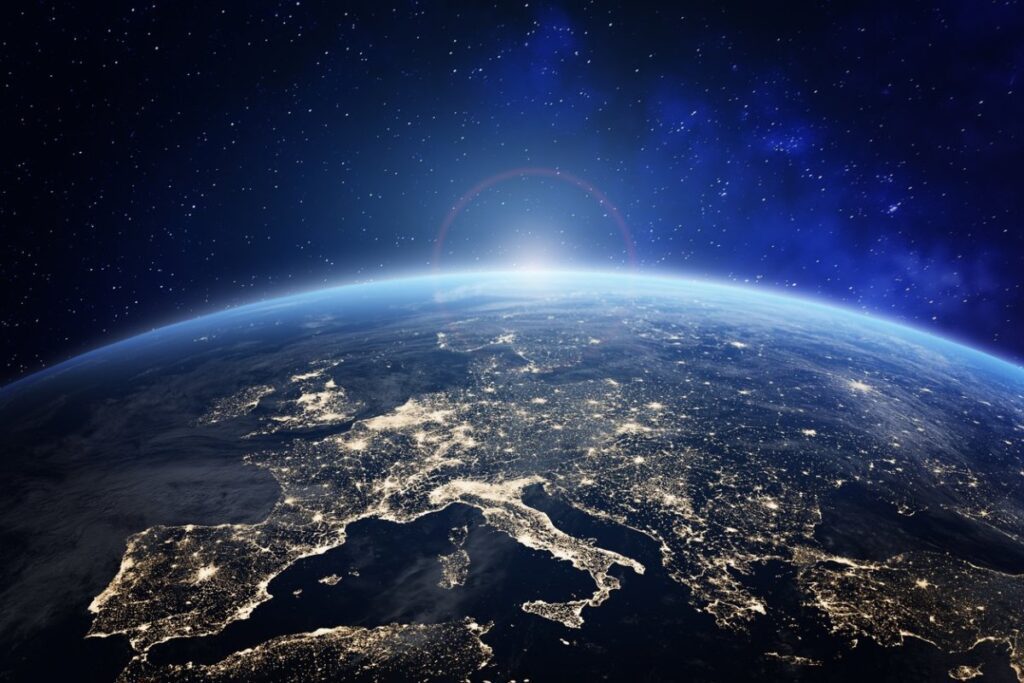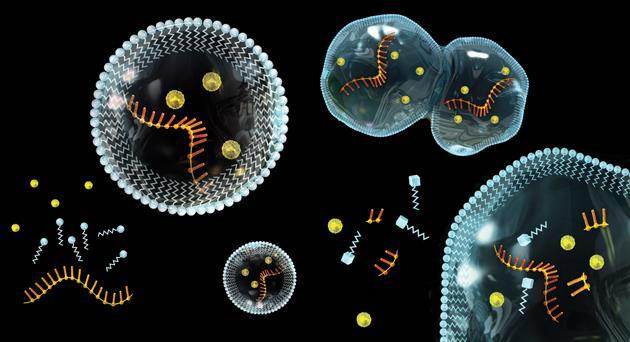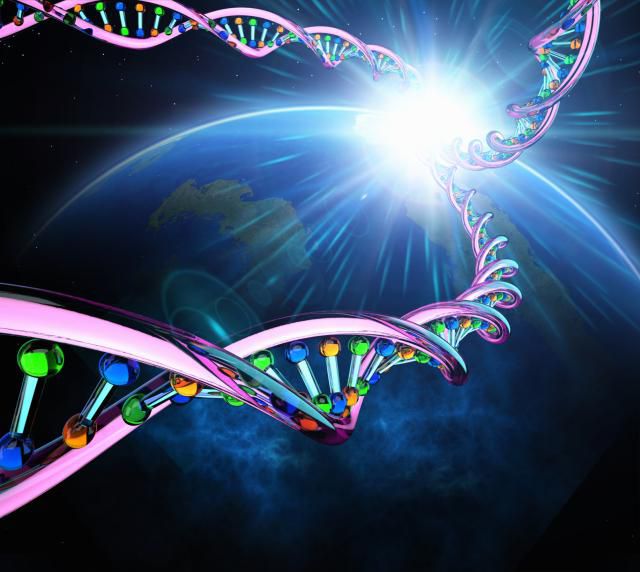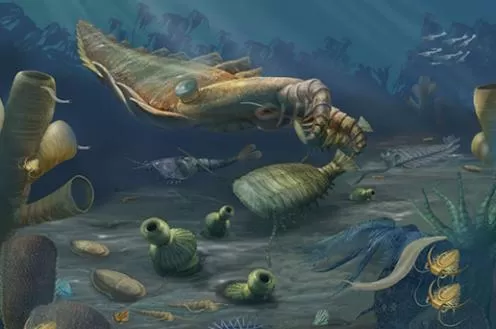The Origin of Life: A Captivating Tale of Earth’s Early Days
The Mystery of Life’s Origin
The question of how life originated on Earth is one of the greatest mysteries that science has yet to solve. Despite decades of research, we still do not know exactly how the first living organisms existed. The reason why it is so difficult to find a satisfactory answer lies in the fact that life emerged billions of years ago, leaving little evidence for us to work with.
However, scientists have formulated several theories on the subject, each with strengths and weaknesses. One popular theory suggests that life could have started from simple organic molecules combined naturally under certain conditions.
Another theory proposes that life arrived on Earth from space through comets or meteorites carrying living microorganisms. While these theories are fascinating, they only partially explain the origin of life and fail to address many details about how it happened.
The Significance of Understanding Life’s Beginnings
Understanding how life began is critical for several reasons. It can help us answer fundamental questions about our place in the universe and our purpose as conscious beings.
It can also provide insights into potential forms extraterrestrial life might take if it exists elsewhere in the universe. Furthermore, understanding how living organisms emerged from nonliving matter can inform our understanding of how other complex systems emerge from simpler ones in nature.
Understanding the origin of life can help us appreciate just how special and precious all forms of life are. To comprehend what elements had to come together for even simple organisms to evolve out from nothingness requires an appreciation for just how rare and unique this planet we live on truly is.
Overview: The Story To Be Told
This article will explore key events throughout Earth’s history that gave rise to complex living organisms like ourselves. We start at Earth’s formation and the conditions in its early days, which set the stage for life to emerge. We then examine scientific theories about how the first living organisms came to be, including their gradual evolution into more complex forms like eukaryotes.
We will also be exploring extinction events, the adaptations that allowed for survival through them, and how early hominids played a role in shaping human evolution. We will touch on what understanding the origin of life can tell us about our place in this world and beyond.
Setting the Scene: Earth’s Early Days
Formation of Earth
The formation of Earth is a fascinating and complex process that began approximately 4.6 billion years ago. Scientists believe that our planet was formed through accretion, where small particles collided and stuck together over millions of years.
These particles eventually formed larger bodies, such as asteroids and comets, which collided to form the planets in our solar system. As Earth began to take shape, it was bombarded by asteroids and meteors, which caused massive craters and released large amounts of heat.
This intense heat resulted in the melting of Earth’s surface, creating a molten magma ocean. Over time, this magma ocean cooled and solidified into the rocky crust that forms our planet’s surface today.
Conditions on early Earth
The conditions on early Earth were vastly different from what we experience today. The atmosphere was composed primarily of nitrogen, carbon dioxide, water vapour, hydrogen gas, and trace amounts of other gases such as methane and ammonia. There was no oxygen present in the atmosphere at this time.
Additionally, early Earth was constantly bombarded by intense radiation from space due to a weaker magnetic field than we have now. This radiation caused widespread ionization in the atmosphere and on the planet’s surface.
Another important aspect to consider is that early Earth experienced much more volcanic activity than it does today. Volcanic eruptions released large amounts of gases into the atmosphere, including water vapour (H2O), carbon dioxide (CO2), sulfur dioxide (SO2), nitrogen (N2), ammonia (NH3), methane (CH4) which contributed to its composition.
Emergence of Organic Molecules
Scientists have long been fascinated with how organic molecules could have emerged on early Earth under these extreme conditions. One theory is that the first organic molecules were formed through abiogenesis, where non-living matter gave rise to living organisms.
Another theory is that organic molecules were brought to Earth by comets or meteorites, which contained the building blocks of life. Regardless of how they formed, the emergence of organic molecules was a crucial step in the origin of life on our planet.
In 1952, Stanley Miller and Harold Urey experimented to test whether organic molecules could be formed under early Earth conditions. They simulated lightning strikes in a mixture of gases thought to be present during this time and found that several amino acids had been produced.
Overall, the emergence of Earth’s early days set the stage for what would eventually become a thriving planet teeming with life. Understanding the conditions and processes that led to this point is crucial for unravelling the mysteries behind life’s origin.
The First Life Forms
Life on Earth began about 3.5 billion years ago, but the exact origin of life remains shrouded in mystery. Scientists have proposed several theories, but none have been proven beyond doubt. The most widely accepted theory suggests that life emerged from a primordial soup of organic molecules in early Earth’s oceans.
Definition of Life
Before discussing the first life forms, define what we mean by ‘life.’ According to biologists, living organisms share certain characteristics, such as growing and reproducing, responding to stimuli, maintaining homeostasis and evolving over time through natural selection. These traits are collectively known as the criteria for life.
Evolutionary Theories on the First Life Forms
Several competing theories exist on how the first life forms emerged on Earth. Some scientists suggest that lightning strikes or UV radiation played a role in creating organic molecules like amino acids and nucleotides- building blocks for proteins and DNA, respectively- which were then assembled into more complex structures like membranes and RNA-like molecules capable of replication.
Others hypothesize that meteorites containing prebiotic organic compounds or hydrothermal vents provide more plausible conditions for prebiotic chemistry. A third possibility posits that simple self-replicating systems could arise spontaneously due to favourable thermodynamic conditions caused by fluctuations in energy gradients within protocellular compartments.
Prokaryotes and their Role in Shaping Early Earth
The first undisputed fossils of prokaryotic organisms date back around 3.5 billion years ago, when archaea started appearing around 2/7ths billion. Archaea are single-celled microorganisms that lack nuclei and other membrane-bound organelles found in eukaryotes (more complex cells).
They were the dominant life form on Earth for billions of years and played a crucial role in shaping the planet’s early environment. Prokaryotes helped to create Earth’s atmosphere by releasing oxygen as a waste product of their metabolic processes.
This created a favourable environment for the evolution of eukaryotic cells and, eventually, multicellular organisms. Additionally, prokaryotes have been instrumental in cycling nutrients throughout Earth’s ecosystems, supporting all higher life forms today.
The Rise of Oxygen and Eukaryotes

The Great Oxygenation Event
The Great Oxygenation Event (GOE) refers to a significant point in Earth’s history when oxygen levels in the atmosphere increased dramatically. For hundreds of millions of years, the atmosphere was primarily composed of carbon dioxide, methane, and other gases that did not contain oxygen.
The emergence of photosynthetic organisms began to change this composition as they released oxygen as a byproduct. However, it wasn’t until cyanobacteria evolved that oxygen levels surged upwards around 2.4 billion years ago during the GOE.
The increase in atmospheric oxygen profoundly affected the evolution of life on Earth. It allowed more complex organisms to evolve and paved the way for emerging eukaryotic cells with advanced respiratory systems.
Emergence and Evolution of Eukaryotic Cells
Eukaryotic cells are more complex than their prokaryotic counterparts, containing a nucleus and membrane-bound organelles such as mitochondria and chloroplasts. The exact origin of eukaryotes remains a mystery; however, it is widely believed that they emerged through endosymbiosis – where one organism lives inside another. Endosymbiosis theory proposes that mitochondria were once free-living bacteria that entered into a symbiotic relationship with an ancestor to modern-day eukaryotes.
Over time this relationship became so beneficial to both organisms over time that mitochondrial DNA integrated into the host cell’s nucleus. After this initial endosymbiotic event occurred around two billion years ago, further evolutionary adaptations within eukaryotes led to even more complex life forms.
Endosymbiotic Theory & The Origin of Mitochondria
Mitochondria are often called “the powerhouse” or “energy factory” of the cell due to their role in producing ATP, which fuels cellular processes. But how did they come to occupy this critical role?
Endosymbiotic theory suggests that the ancestor to modern-day eukaryotes engulfed a free-living bacterium capable of aerobic respiration. This bacterium was then incorporated into the host cell as an endosymbiont, giving rise to mitochondria.
The presence of mitochondria enabled eukaryotic cells to generate far more energy than prokaryotes, allowing them to become larger and more complex. Over time, mitochondria evolved in a way that allowed for greater efficiency and specialization, contributing significantly to the evolution of life on Earth.
The Implications
The emergence and evolution of eukaryotic cells with advanced respiratory systems were pivotal events in Earth’s history. They allowed the evolution of complex organisms such as animals, plants, fungi, and even humans.
Understanding these events can offer insight into how life has evolved over billions of years. More than that, it can help us understand our place in this vast tapestry of life – a tiny piece of the grand story that began billions of years ago when oxygen levels began to rise during The Great Oxygenation Event.
Extinction Events and Adaptations

Surviving the Mass Extinctions
The Earth has experienced five mass extinction events throughout its history. Each event wiped out a significant portion of life on Earth, but it also paved the way for new life to emerge.
The most famous of these extinction events is the one that led to the end of the dinosaurs about 65 million years ago. However, four other events had similarly devastating effects.
Despite the catastrophic loss of life during these periods, some species survived. Extinction events are not always a complete wipeout, and those organisms that could adapt were able to persist through these tough times.
For example, during the end-Permian extinction event, which occurred about 252 million years ago and wiped out over 90% of all marine species, some organisms shifted their habitat preference from shallow waters to deeper waters or vice versa. Those that could adapt to changing environments tended to be more likely to survive.
Diversification: The Key Driver of Life’s Evolution
One significant result following an extinction event was diversification – new species would emerge in an environment with fewer resource competitors and less predation pressure from other animals. This phenomenon is evident in the fossil record, with each mass extinction followed by rapid diversification among surviving lineages. Multicellular organisms emerged during Earth’s third major mass extinction event – The End-Devonian Mass Extinction took place around 359 million years ago – and eventually gave rise to complex land plants and animals like insects and amphibians.
Adaptive Radiations: A Recipe for Success
Adaptive radiations are another process by which diversity increases after an ecological opportunity arises following a drastic change in environmental conditions or available resources. In this case, adaptive radiations occur when a single lineage evolves into several forms with unique adaptations that fit them into different ecological niches.
For instance, after the extinction of the dinosaurs, mammals radiated rapidly across a range of habitats, from small insect-eaters to massive herbivores. Birds rapidly diversified following the extinction of non-avian dinosaurs, leading to over 10,000 bird species today.
The Future of Life on Earth
The history of life on Earth has shown that while mass extinctions may bring about significant biodiversity losses, they can also create opportunities for new species to emerge and diversify. However, human activities are also causing widespread extinctions at an unprecedented rate. The extinction rate is estimated to be 1000 times higher than the historical background rate.
Learning from the past and developing strategies to mitigate this loss by preserving natural habitats, preventing invasive species from taking over local ecosystems, and reducing greenhouse gas emissions is essential. Only then can we hope for a sustainable future for life on Earth?
The Human Connection: From Primordial Soup to Homo Sapiens

Human Evolution from Primates to Homo Sapiens
The human story is one of the most intriguing and captivating tales in the history of life on Earth. It has been shaped by hundreds of millions of years of evolution, starting with our earliest primate ancestors.
Over time, the hominid lineage gave rise to many species, each with unique adaptations and characteristics that allowed them to survive and thrive in a changing world. The story continues today as we explore our place in the natural world and seek to understand our origins.
The earliest primate ancestors likely lived about 60 million years ago, shortly after the dinosaurs went extinct. These small creatures were adapted for life in trees, with grasping hands and feet that allowed them to move easily among branches.
Over time, some species began to develop larger brains, which enabled more complex social behaviour and increased adaptability. By about 6 million years ago, hominids had evolved from the ape-like Australopithecus into a new genus called Homo.
This genus included early humans such as Homo habilis and Homo erectus, characterized by larger brains and a more upright posture than their earlier ancestors. Around 200 thousand years ago, modern humans—Homo sapiens—emerged in Africa.
These early humans had sophisticated tool-making abilities and were capable of complex social organization. They rapidly spread across the globe in search of new resources and opportunities.
The Role Early Hominids Played in Shaping Human Evolution
Early hominids played a crucial role in shaping human evolution by adapting to changing environments over millions of years. They developed larger brains than their predecessors; they learned how to use tools; they walked on two legs instead of four; they learned how to communicate through language. Early hominids developed one of the most important adaptations: bipedalism, or walking on two legs.
This allowed them to move more efficiently across the ground and freed up their hands for other activities—such as carrying food or tools. Additionally, it is thought that this adaptation may have contributed to the development of larger brains by freeing up energy that would otherwise have been spent on locomotion.
Another key adaptation was tool use. Early hominids developed the ability to fashion simple tools from stone, wood, and other materials.
This allowed them to access new food sources and protect themselves from predators. Tool-making also required planning, problem-solving skills, and manual dexterity—all of which may have contributed to the development of larger brains over time.
How Understanding the Origin of Life Can Inform Our Understanding of Human Existence
By exploring the origin of life on Earth, we can gain a deeper understanding of our place in the natural world. The story of life’s beginnings underscores our interconnectedness with all living things and helps us appreciate just how remarkable it is that we are here. Moreover, understanding human evolution can help us better understand our biology and behaviour—and perhaps even shed light on some of humanity’s most pressing challenges today.
By examining how early humans adapted to changing environments over millions of years, we may gain insights into how we can adapt to current challenges such as climate change or emerging diseases. Ultimately, exploring the origin of life and human evolution can inspire us to think about our place in a broader context—and help us appreciate just how extraordinary it is that we are alive today.
Conclusion
The story of the origin of life is fascinating, full of twists and turns that have shaped the planet we call home. From the earliest organic molecules to the emergence of complex multicellular organisms, the history of life on Earth is a testament to the resilience and adaptability of living things. Understanding this history helps us appreciate our place in the grand scheme of things and inform our efforts to protect and preserve life on our planet.
The Limits of Our Knowledge
Despite all that we know about the origin of life, there are still many mysteries that remain unsolved. How exactly did life emerge from non-life? What were the first living things like?
How did eukaryotic cells evolve? These questions may never be fully answered, but they motivate scientists to continue exploring and learning more about our world.
The Power of Adaptation
One thing that becomes clear when studying the origin of life is just how powerful adaptation can be. From simple prokaryotes to complex multicellular organisms, living things have found ways to survive and thrive in challenging conditions. This gives us hope for our ability to adapt as we face challenges like climate change and other environmental threats.
The Importance of Preservation
Studying the origin of life reminds us just how precious all forms of life are. We are not alone on this planet – we share it with millions upon millions of other species, each with its own unique story to tell.
As stewards of this world, we must protect and preserve these forms of life for future generations. By appreciating their origins and understanding their place in the ecosystem, we can work together towards a brighter future for all living things on Earth.
